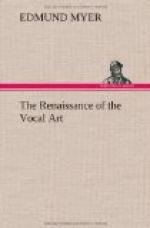Sing this exercise in all degrees of power, soft, medium and loud, maintaining the same true conditions on all. The tendency of most singers is to relax and depress on soft tone, or to pinch and contract. Soft tone should never be small in form, and it should always have the same vitality and energy as the louder tone.
[Illustration: FIFTH STUDY. Ah....]
This exercise should be studied and practiced in every way suggested for the study of the preceding exercises. Place yourself upon a level with the first tone, in the manner before described, and thus secure the automatic breath. Do not forget to use the hands to suggest the movement to the body. The hands should be used until the body is thoroughly trained to flexible action. It is always a question of “the thought before the action.” Do not allow a conscious or local breath before the movement.
Place yourself upon a level with the first tone, and allow or let the voice start spontaneously and freely. Make no effort to hold the breath. Hold from position. Sing down, moving with the voice, but do not let the body or the tone droop or relax. Neither must there be stiffness or contraction. If you find it impossible to control the voice in this way, or to prevent depression of body and of tone, then try the following way.
Place yourself upon a level with the first tone in the proper manner, sing down, but lift and expand with an ascending movement of the hands and body. Open the mouth freely and naturally, and let the tone roll out. You will be surprised to find not only great breath power and control, but a power in the tone that most singers imagine can be got through physical force alone. This power is the result of expansion and inflation, the true reinforcing power. The increased vitalized energy of the tone is the result of the upward and outward movement. This movement of expansion and inflation through flexible action, is the true application of strength or of power. It is that which we call the reverse movement. We sing down and move up. It is the great movement for developing the low tones of all voices. This reverse movement may be applied at will to all the studies given; it will depend upon the effect we may desire to produce. If in descending, a quiet effect is desired, the movement is with the voice. If we want power we reverse the action. The body, when properly trained, becomes the servant of the will, and responds instantly to thought and desire. Hence the importance of correct thought.




